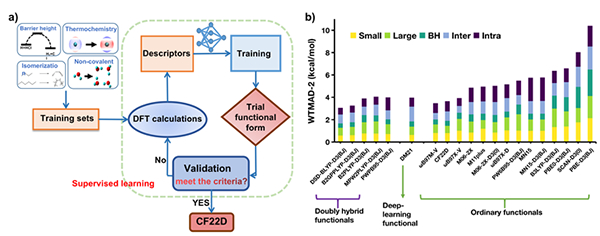
Figure. (a) The workflow of the development of CF22D. (b) Performance of CF22D and other representative functionals on the GMTKN55 Database and its subdatabases.
Supported by the National Natural Science Foundation of China (Grant Nos: 21922301, 22273023, 21903024), Professor Xiao He from East China Normal University, Professor Ying Wang from Hunan Normal University and Professor Donald G. Truhlar from the University of Minnesota, US, have made progress in the development and application of density functional theory. Their article entitled "Supervised Learning of a Chemistry Functional with Damped Dispersion", was published online in Nature Computational Science on December 23, 2022. The link to the article is: http://www.nature.com/articles/s43588-022-00371-5.
Density functional theory is one of the most widely used electronic structure methods for many-electron system, and it has become a powerful tool in theoretical and computational chemistry. However, its prediction accuracy depends strongly on the choice of density functional, and the development of an accurate and universal density functional is a key scientific problem in chemistry. Prior to the novel work these authors reported, no existing density functional could simultaneously provide accurate results for main-group chemistry, transition metal chemistry, and solid-state physics.
The above research team developed a new density functional named CF22D, which is universally applicable to various types of molecular systems, by building accurate and diverse chemical property databases, introducing new physical descriptors, and utilizing a supervised learning scheme. They chose a flexible functional form that combines a global hybrid meta nonseparable gradient approximation that depends on density and occupied orbitals with a damped dispersion term that depends on geometry. This enabled the CF22D functional to provide universally reliable predictions for molecular energetics, barrier heights, and noncovalent interactions, including the properties of large molecules where the additive effect of many noncovalent interactions is not negligible. The energy functional was optimized by using a new performance-triggered iterative supervised training strategy involving a new, high-precision, diverse chemical property database, named DDB22, and this yielded a universal chemistry functional with higher across-the-board accuracy for both main-group and transition-metal chemistry. The CF22D functional has higher prediction accuracy than most other popular density functionals (see Figure). It even performs better than some doubly-hybrid functionals, which are more computationally demanding.
The CF22D functional provides a new tool for theoretical and computational chemistry that can be useful for a wide variety of applications, including bond energies, isomerization energies, thermochemistry, barrier heights and noncovalent interactions of molecules containing main-group elements and transition metals.

Add: 83 Shuangqing Rd., Haidian District, Beijing, China
Postcode: 100085
Tel: 86-10-62327001
Fax: 86-10-62327004
E-mail: bic@donnasnhdiary.org
京ICP备05002826号 文保网安备1101080035号 Copyright 2017 NSFC, All Right Reserved